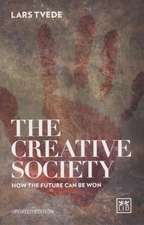Patterns of Resource Allocation Decisions in Organisations: ebs-Forschung, Schriftenreihe der EUROPEAN BUSINESS SCHOOL Schloß Reichartshausen, cartea 53
Autor Robert Urlichs Cuvânt înainte de Prof. Dr. Jean-Paul Thommen und Ansgar Richter, PhDen Limba Engleză Paperback – 25 noi 2005
Din seria ebs-Forschung, Schriftenreihe der EUROPEAN BUSINESS SCHOOL Schloß Reichartshausen
- 5%
 Preț: 439.58 lei
Preț: 439.58 lei - 15%
 Preț: 545.15 lei
Preț: 545.15 lei -
 Preț: 419.81 lei
Preț: 419.81 lei -
 Preț: 420.58 lei
Preț: 420.58 lei -
 Preț: 427.11 lei
Preț: 427.11 lei -
 Preț: 358.58 lei
Preț: 358.58 lei -
 Preț: 318.44 lei
Preț: 318.44 lei -
 Preț: 426.56 lei
Preț: 426.56 lei -
 Preț: 358.20 lei
Preț: 358.20 lei -
 Preț: 425.20 lei
Preț: 425.20 lei -
 Preț: 423.84 lei
Preț: 423.84 lei -
 Preț: 423.84 lei
Preț: 423.84 lei - 15%
 Preț: 470.72 lei
Preț: 470.72 lei -
 Preț: 454.53 lei
Preț: 454.53 lei -
 Preț: 422.70 lei
Preț: 422.70 lei -
 Preț: 422.90 lei
Preț: 422.90 lei -
 Preț: 429.22 lei
Preț: 429.22 lei -
 Preț: 420.20 lei
Preț: 420.20 lei -
 Preț: 420.02 lei
Preț: 420.02 lei -
 Preț: 427.49 lei
Preț: 427.49 lei -
 Preț: 360.53 lei
Preț: 360.53 lei -
 Preț: 422.52 lei
Preț: 422.52 lei -
 Preț: 432.88 lei
Preț: 432.88 lei -
 Preț: 421.72 lei
Preț: 421.72 lei -
 Preț: 420.58 lei
Preț: 420.58 lei -
 Preț: 487.75 lei
Preț: 487.75 lei - 15%
 Preț: 529.60 lei
Preț: 529.60 lei - 15%
 Preț: 500.73 lei
Preț: 500.73 lei -
 Preț: 421.17 lei
Preț: 421.17 lei -
 Preț: 421.34 lei
Preț: 421.34 lei -
 Preț: 422.11 lei
Preț: 422.11 lei - 15%
 Preț: 526.83 lei
Preț: 526.83 lei - 15%
 Preț: 531.26 lei
Preț: 531.26 lei - 15%
 Preț: 500.42 lei
Preț: 500.42 lei - 15%
 Preț: 442.01 lei
Preț: 442.01 lei - 15%
 Preț: 451.32 lei
Preț: 451.32 lei - 15%
 Preț: 535.01 lei
Preț: 535.01 lei -
 Preț: 453.98 lei
Preț: 453.98 lei -
 Preț: 491.82 lei
Preț: 491.82 lei - 15%
 Preț: 440.67 lei
Preț: 440.67 lei -
 Preț: 387.20 lei
Preț: 387.20 lei -
 Preț: 393.35 lei
Preț: 393.35 lei -
 Preț: 384.86 lei
Preț: 384.86 lei -
 Preț: 382.18 lei
Preț: 382.18 lei - 15%
 Preț: 584.58 lei
Preț: 584.58 lei -
 Preț: 390.08 lei
Preț: 390.08 lei - 15%
 Preț: 546.13 lei
Preț: 546.13 lei -
 Preț: 388.90 lei
Preț: 388.90 lei - 15%
 Preț: 444.79 lei
Preț: 444.79 lei
Preț: 386.81 lei
Nou
Puncte Express: 580
Preț estimativ în valută:
74.02€ • 80.38$ • 62.18£
74.02€ • 80.38$ • 62.18£
Carte tipărită la comandă
Livrare economică 22 aprilie-06 mai
Preluare comenzi: 021 569.72.76
Specificații
ISBN-13: 9783835002098
ISBN-10: 3835002090
Pagini: 246
Ilustrații: XXI, 246 p. 8 illus.
Dimensiuni: 155 x 225 x 17 mm
Greutate: 0.39 kg
Ediția:Softcover reprint of the original 1st ed. 2005
Editura: Deutscher Universitätsverlag
Colecția Deutscher Universitätsverlag
Seria ebs-Forschung, Schriftenreihe der EUROPEAN BUSINESS SCHOOL Schloß Reichartshausen
Locul publicării:Wiesbaden, Germany
ISBN-10: 3835002090
Pagini: 246
Ilustrații: XXI, 246 p. 8 illus.
Dimensiuni: 155 x 225 x 17 mm
Greutate: 0.39 kg
Ediția:Softcover reprint of the original 1st ed. 2005
Editura: Deutscher Universitätsverlag
Colecția Deutscher Universitätsverlag
Seria ebs-Forschung, Schriftenreihe der EUROPEAN BUSINESS SCHOOL Schloß Reichartshausen
Locul publicării:Wiesbaden, Germany
Public țintă
ResearchCuprins
1 Introduction.- 1.1 Problem and research objective.- 1.2 Research design.- 1.3 Structure of the thesis.- 2 Classical and behavioural perspectives on decisions-making.- 2.1 The classical perspective on individual decision-making.- 2.2 The behavioural perspective on individual decision-making.- 2.3 The behavioural perspective on organisational decision-making.- 3 Similarity and patterns of decision outcomes.- 3.1 Definitions of decision outcome, similarity and pattern.- 3.2 Similarity and patterns in the classical perspective on decision-making.- 3.3 Similarity and patterns in the behavioural perspective on decision-making.- 3.4 Excursus: Strategy and the perspectives on decision-making.- 3.5 Summary.- 4 Research design, data and methods.- 4.1 Design of the case illustration.- 4.2 Data gathering and variables in the outside perspective on decisions.- 4.3 Perspective of decision-makers on patterns of decisions.- 4.4 Analytical methods.- 4.5 Summary and critical evaluation.- 5 Results.- 5.1 Results of similarity analysis.- 5.2 Results of cluster analysis.- 5.3 Results of analysis of patterns of decision outcomes.- 5.4 Summary of results.- 6 Discussion and implications.- 6.1 Discussion of results.- 6.2 Excursus: Discussion of strategy and the perspectives on decision-making.- 6.3 Theoretical and managerial implications.- 7 Conclusion.- 7.1 Summary.- 7.2 Limitations of the research and options for future research.- Appendix A. Intercoder reliability for Novartis.- Appendix B. Means, standard deviations and correlations.- Appendix C. Interview guide.- References.
Notă biografică
Dr. Robert Urlichs promovierte bei Prof. Dr. Jean-Paul Thommen am Department "International Management and Consulting" an der European Business School, Schloß Reichartshausen. Er ist als Unternehmensberater für McKinsey & Company, Inc., tätig.
Textul de pe ultima copertă
Although decision-making is widely regarded as being based on rigour analysis of the advantages and disadvantages of the decision alternatives in a specific situation, managers do not always take decisions in isolation. Rather, they are embedded in a social and organisational environment, which serves as orientation for decision-making. Being embedded in social environments, the outcomes of decisions taken in organisations are characterised by systematic similarities that can be interpreted as patterns of decisions.
Based on publicly available data on the outcomes of resource allocation decisions of the two pharmaceutical and chemical companies Ciba and Sandoz, Robert Urlichs investigates more than 1,000 decisions. He analyses this data base in a combination of quantitative and qualitative techniques and identifies patterns of decision outcomes. The results reveal that patterns of decision outcomes develop within and even across organisations. Organisational decision-making seems to be biased by the outcomes of prior decisions taken in the same and in other organisational units. An excursus shows that many of the identified patterns of decisions can be interpreted as realised strategies, which have emergent and deliberate elements. Therefore, the author brings life to Mintzberg's notion of realised strategy as a pattern in a stream of decisions, providing an empirical basis and analytical methodology.
Based on publicly available data on the outcomes of resource allocation decisions of the two pharmaceutical and chemical companies Ciba and Sandoz, Robert Urlichs investigates more than 1,000 decisions. He analyses this data base in a combination of quantitative and qualitative techniques and identifies patterns of decision outcomes. The results reveal that patterns of decision outcomes develop within and even across organisations. Organisational decision-making seems to be biased by the outcomes of prior decisions taken in the same and in other organisational units. An excursus shows that many of the identified patterns of decisions can be interpreted as realised strategies, which have emergent and deliberate elements. Therefore, the author brings life to Mintzberg's notion of realised strategy as a pattern in a stream of decisions, providing an empirical basis and analytical methodology.










